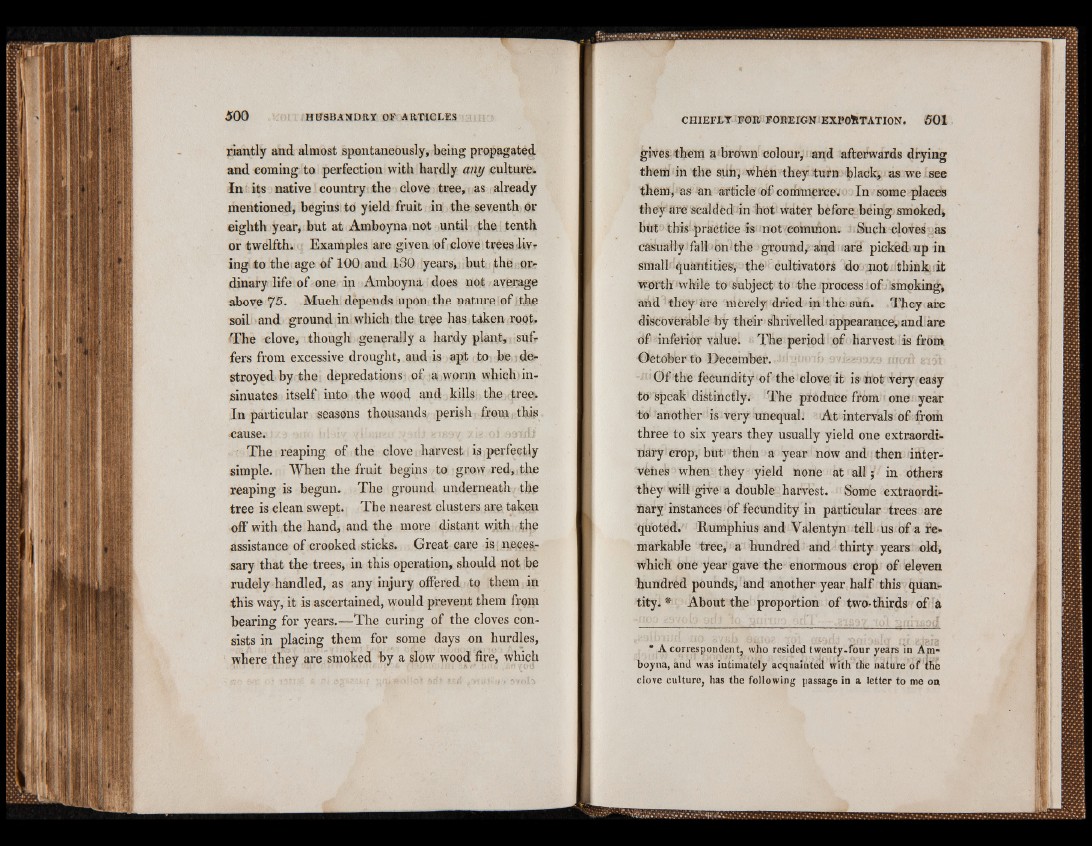
riantly and almost spontaneously, being propagated
and coming to perfection with hardly any culture.
In its native country the clove tree, as already
mentioned, begins to yield fruit in the seventh or
eighth year, but at Amboyna not until the tenth
or twelfth. Examples are given of clove trees living
to the age of 100 and 130 years, but the ordinary
life of one in Amboyna does not average
above 75. Much depends upon the nature of the
soil and ground in which the tree has taken roof.
The clove, though generally a hardy plant, suffers
from excessive drought, and is apt to be destroyed
by the depredations^ of a worm which insinuates
itself into the wood and kills the tree.
In particular seasons thousands, perish from this
cause.
The reaping of the clove harvest is perfectly
simple. When the fruit begins to grow red, the
reaping is begun. The ground underneath the
tree is clean swept. The nearest clusters are taken
off with the hand, and the more distant with the
assistance of crooked sticks. Great care is. necessary
that the trees, in this operation, should not be
rudely handled, as any injury offered tq them in
this way, it is ascertained, would prevent them from
bearing for years.—The curing of the cloves consists
in placing them for some days on hurdles,
where they are smoked by a slow wood fire, which
gives them a brown colour, and afterwards drying
them in the sun, when they turn black, as we see
them, as an article of commerce. In some places
they are scalded in hot water before being smoked,
but this1 practice is not common. Such cloves as
casually fall on the ground, and are picked up in
small quantities, the cultivators do not think it
worth while to subject to the process of smoking,
and they are merely dried in the sun. They are
discoverable by their shrivelled appearance,’and are
of inferior value. The period of harvest is from
October to December.
Of the fecundity of the clove it is not very easy
to speak distinctly. The produce from one year
to another is very unequal. At intervals of from
three to six years they usually yield one extraordinary
crop, but then a year now and then intervenes
when they yield none at all; in others
they will give a double harvest. Some extraordinary
instances Of fecundity in particular trees are
quoted, llumphius and Valentyn tell us of a remarkable
tree, a hundred and thirty years old,
which one year gave the enormous crop of eleven
hundred pounds, and another year half this quantity.
* About the proportion of two-thirds of a
* A correspondent, who resided twenty-four years in Amboyna,
ànd was intimately acquainted with the nature of iHe
clove culture, has the following passage in a letter to me on